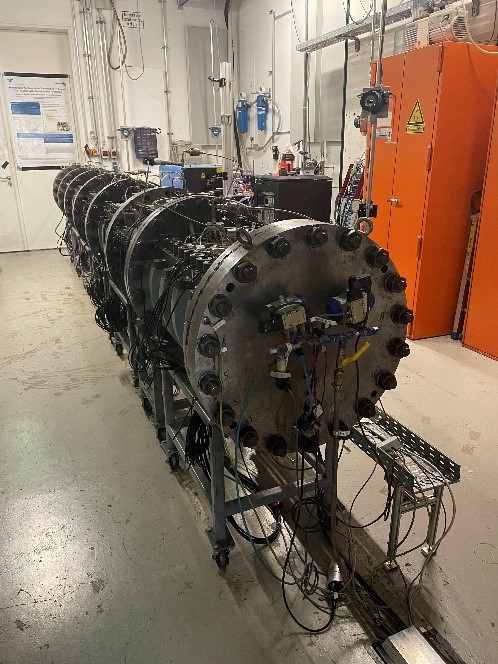Reliability and Safety: Hydrogen and Refrigerants
Gas mixtures consisting of large amounts of hydrogen (H2) and carbon monoxide (CO) are extensively used in chemical engineering processes, e. g. syngas from reforming or gasification. However, depending on the composition, the gas mixture exhibits a wide explosive range. Consequently, understanding and predicting the conditions for handling the mixture safely is of importance. Especially, the potential development of a H2/CO mixture in severe accident scenarios of nuclear power plants is of great concern and requires research on a fundamental level.
Ongoing Research: Determination of Characteristics of Slow to Fast H2-CO Combustion and Derivation of Risk Criteria (H2CORisk)
| Cooperation and Funding | Federal Ministry for Economic Affairs and Climate Action |
Motivation
Conditions that might jeopardize the integrity of the containment in nuclear power plants can occur for example, if the fuel rods are damaged and H2 is formed through metal oxidation reactions – particularly zirconium oxidation. Further, concrete-melt interaction (Molten Core Concrete Interaction - MCCI) can occur, in which CO is released in addition to H2. Due to buoyancy effects, the gas mixture accumulates under the roof of the building establishing a stratified, semi confined gas layer. If H2 or H2/CO is present together with oxygen (O2) in a sufficient concentration, ignition by hot surfaces or sparks is highly probable. The combustion process that follows might increase the pressure and temperature. In particular, fast turbulent-accelerated combustion and deflagration to detonation transition (DDT) or detonation are safety relevant, since related high local pressure peaks might damage the integrity of building structure. In worst case assumptions the outer barrier between the nuclear inventory and the environment might be destroyed, e.g., Fukushima 2011 [1].
Aiming to avoid similar severe accident events in the future, the present research project H2CORisk is going to improve the scientific understanding by providing new experimental insights into deflagrative combustion processes of H2/CO/air-mixtures in partial containment. Specifically, conventional and optical measurement techniques are going to be used to obtain results that allow for the derivation of a sigma criterion for flame acceleration. Furthermore, the experimental results are going to be used for validating simulation results generated by an OpenFoam based CFD code under development at the Chair of Thermodynamics, TUM. H2CORisk is part of the KEK program (Competence preservation in Nuclear Technology at GRS).
Experimental Setup
The experimental measurements are going to be carried out on the GraVent test rig at TUM, see Fig. 1. The rig, that has been used in various studies at the Chair of Thermodynamics, consists of a rectangular explosion channel with a total length of six meters [2-4]. It allows to establish vertical gas mixture gradients as well as homogeneous gas-air-distributions before the ignition. The shape of the channel is variable, as different blockage ratios (BR) inside of the test rig can be realized by the installation of obstacles. Pressure data can be gathered by several static and dynamic pressure sensors spread along the channel. Flame velocities are going to be determined using ionization sensors placed in the channel’s ceiling. Besides, the OH-PLIF technique is going to be used for flame visualization. An optical segment can be placed at different positions in the channel. The results on the flame topology will provide valuable insights into combustion instabilities in early stages of the flame acceleration in H2/CO/air-mixtures.
References
- R. Gauntt, D. Kalinich, J. Cardoni, J. Phillips, A. Goldmann, S. Pickering, M. Francis, K. Robb, L. Ott, D. Wang, et al. Fukushima daiichi accident study (status as of april 2012). Sandia National Laboratory Report, SAND2012-6173, Albuquerque, NM, 2012.
- L.R. Boeck, M. Kellenberger, G. Rainsford, and G. Ciccarelli. Simultaneous oh-plif and schlieren imaging of flame acceleration in an obstacle-laden channel. Proceedings of the Combustion Institute, 36(2):2807–2814, 2017.
- L.R. Boeck, P. Katzy, J. Hasslberger, A. Kink, and T. Sattelmayer. The gravent ddt database. shock waves. Website, 2016. Online available at https://www.mw.tum.de/td/forschung/ddt/.
- L.R. Boeck, J. Hasslberger, and T. Sattelmayer. Flame acceleration in hydrogen/air mixtures with concentration gradients. Combustion Science and Technology, 186(10-11):1650–1661, 2014.
Acknowledgements
The presented work is funded by the German Federal Ministry of Economic Affairs and Climate Action on the basis of a decision by the German Bundestag which is gratefully acknowledged.
